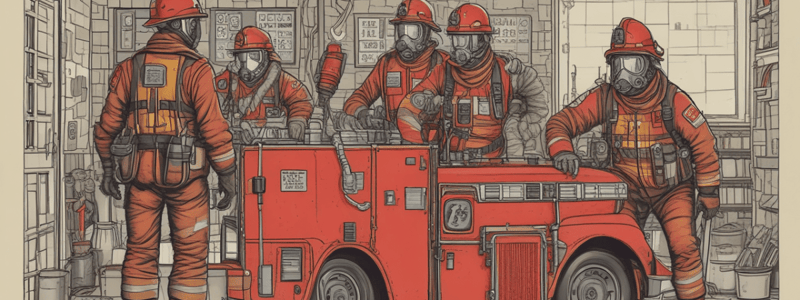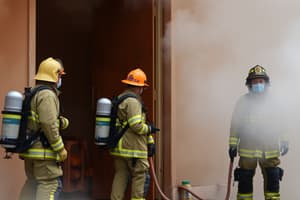Podcast
Questions and Answers
What are clan labs also known as?
What are clan labs also known as?
- Drug manufacturing units
- Narcotics laboratories or production houses (correct)
- Narcotics dispensaries
- Chemical storage facilities
Where can clan labs be located?
Where can clan labs be located?
- Only in fixed locations
- Anywhere, including houses, campers, boats, vans, and warehouses (correct)
- Only in abandoned buildings
- Only in houses and warehouses
What is the purpose of a clan lab?
What is the purpose of a clan lab?
- To manufacture legal drugs
- To manufacture illegal drugs as economically and quickly as possible for sale on the street (correct)
- To conduct chemical research
- To store chemicals safely
What may indicate the presence of a clan lab?
What may indicate the presence of a clan lab?
What should TFS personnel consider upon arrival at a clan lab?
What should TFS personnel consider upon arrival at a clan lab?
What can exposure to chemicals in a clan lab result in?
What can exposure to chemicals in a clan lab result in?
What should be avoided during fire suppression activities at a clan lab?
What should be avoided during fire suppression activities at a clan lab?
Why should nothing be moved or touched at a clan lab?
Why should nothing be moved or touched at a clan lab?
What should be done if suspected clan lab operators are encountered?
What should be done if suspected clan lab operators are encountered?
What may be used to protect a clan lab?
What may be used to protect a clan lab?
What is the purpose of the guidelines for responding to emergency incidents at clandestine drug laboratories?
What is the purpose of the guidelines for responding to emergency incidents at clandestine drug laboratories?
Who is responsible for ensuring that personnel follow established guidelines for responses to clan labs?
Who is responsible for ensuring that personnel follow established guidelines for responses to clan labs?
What is the primary reason for the increase in the number of clan labs in recent years?
What is the primary reason for the increase in the number of clan labs in recent years?
What is the minimum requirement for entering a clan lab?
What is the minimum requirement for entering a clan lab?
What is the role of the Incident Commander in a clan lab incident?
What is the role of the Incident Commander in a clan lab incident?
What should be considered by the Incident Commander in a clan lab incident?
What should be considered by the Incident Commander in a clan lab incident?
What is the limitation of wearing PPE with SCBA in a clan lab?
What is the limitation of wearing PPE with SCBA in a clan lab?
Who assists the Incident Commander in contacting or notifying agencies required at the scene?
Who assists the Incident Commander in contacting or notifying agencies required at the scene?
Flashcards are hidden until you start studying
Study Notes
Purpose and Responsibility
- The purpose of this guideline is to provide Toronto Fire Services personnel with a guideline for responding to and safely mitigating emergency incidents at clandestine drug laboratories (clan labs).
- All personnel are responsible for understanding and following proper guidelines at a clan lab incident to ensure the health, safety, and welfare of personnel.
- Company Officers are responsible for ensuring their personnel follow established guidelines for responses to clan labs.
- The Incident Commander is responsible for following guidelines at a clan lab incident to ensure the health, safety, and welfare of personnel and for making all necessary notifications and ensuring all reports and documentation are completed and forwarded.
Background
- The number of clan labs has increased significantly in recent years.
- Clan labs require cooperation and sometimes assistance from TFS when dealing with the Toronto Police Service (TPS) Major Drug Unit and Forensic Identification Unit.
Risk Assessment
- Entry into a clan lab is high risk and shall only be made to conduct a known rescue of human life.
- Under fire conditions with no life hazard, prevent extension and exposure damage but do not enter the hazard area.
- Caution should be exercised as wearing PPE with SCBA may not completely protect personnel from exposure at clan labs.
- The Incident Commander should consider a defensive mode of attack as appropriate to protect personnel from unknown chemical exposure, explosion, and rapid fire advance.
General Information
- Clan labs can be defined as hidden, makeshift, chemical laboratories where dangerous chemicals are stored and used in the manufacture of illegal drugs.
- Clan labs can be located anywhere (houses, campers, boats, vans, warehouses, etc.) and may be fixed, mobile, or transportable.
- Clues that may indicate the presence of a clan lab include blacked-out windows, expensive security systems, metal drums and boxes with labels removed, chemical containers, strong pungent odors, laboratory glassware equipment, heating plates, and makeshift ventilation pipes.
Hazards
- Clan labs pose serious hazards to emergency response personnel and may also endanger residents in the community or contaminate the environment due to the lack of safety control systems, ventilation systems, and knowledge of the clan lab operators.
- Unknown and hazardous chemicals that may be present include common household chemicals, explosives, toxins, radioactive materials, and byproducts of drug production such as deadly phosgene gas.
- The use of water during fire suppression activities may cause a violent explosion or the release of toxic gases.
- Turning on electrical appliances can trigger an explosion.
- Operators of clan labs may not always be familiar with the flammability and reactivity of some chemicals.
- Clan labs may be protected with defense systems or "booby-traps" to deter unwanted visitors, which can cause personal injury or create a life-threatening situation.
- IT IS IMPERATIVE THAT NOTHING IS MOVED, SHUT OFF, TURNED ON, OR TOUCHED AT A LABORATORY, WHETHER IT IS OPERATIONAL OR ABANDONED.
Studying That Suits You
Use AI to generate personalized quizzes and flashcards to suit your learning preferences.




